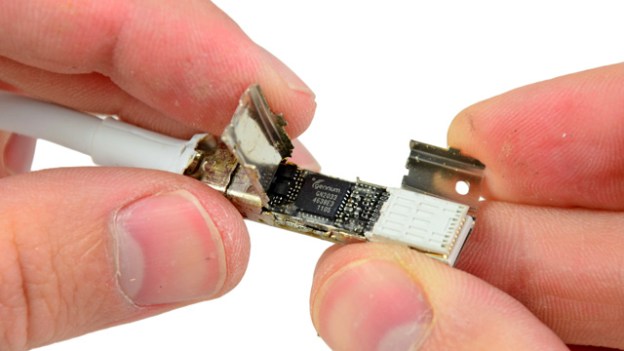
Thunderbolt, the device interconnection technology that offers ridiculously high-speed data transfer rates (10Gbps), is starting to hit the market now. Promise’s Pegasus RAID drives, a secure network storage solution, are the first to support the new tech. If you want to connect one to your Thunderbolt port-equipped Mac, however, you’ll need to buy a separately sold cable for $50. That’s a high price to pay for a two-meter cord (the price on Apple’s website, to the point that iFixit felt compelled to do some digging.
It turns out that your $50 is paying for more than just a length of shielded wire. Tearing open the cable and exposing its innards, iFixit discovered that there’s some actual technology on the inside. Specifically, each beefy connector point contains contains a Gennum GN2033 chip, which is an active-cable transceiver designed especially for Thunderbolt. Situated near each of the two chips are a couple of smaller, minimally marked chips (labeled 1102F SS8370 and 131 3S).
Some further digging on the subject was done by Ars Technica, which learned from a Promise support technician that Apple’s product is a “smart” cable that “has firmware in it.” Another, unnamed telecom source offered some more detail, explaining that smart or active cables contain chips like the ones iFixit discovered that are specially designed to manage the flow of information passing through the wire between them. Doing so “greatly improves the signal-to-noise ratio” for the high data transfer rates that Thunderbolt is capable of.
Active cables are actually quite common nowadays. Most of the wired connections we make with our HDTVs, gaming consoles, smartphones and cameras rely on active cabling with USB, HDMI and DisplayPort connection types. That’s progress, folks; even our cables come packing microchips.
Editors' Recommendations
- How to connect an iPhone to a Mac with or without a cable
- Why Thunderbolt 5 laptops are a big deal
- CableMod’s adapters damaged up to $74K worth of Nvidia GPUs
- The 6 best XLR cables for microphones in 2024
- The 11 best USB-C cables for 2024, chosen by experts


